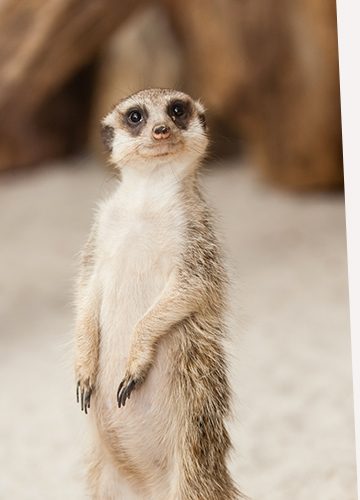Animal Tracker 2018: Importance of Animal Protection
Humans have mixed attitudes when it comes to non-human animals. Some animals are considered family members while others are seemingly just fodder for our industries and appetites. How do our varying attitudes about other animals influence our feelings about the importance of their protection? For over 10 years, the Faunalytics Animal Tracker has monitored answers to this question so that animal advocates can better understand the changing nature of attitudes toward animals in a variety of different situations.
In this blog we dive into how important people think the “welfare and protection” of animals is for various types of animals and situations. Previous blogs covering the 2018 Animal Tracker have described the methodology and overall results, examined opinions of various social causes and political movements, and looked at the credibility of different sources of information about animal welfare.
Following is the question that we ask every three years, most recently in April 2018:
How important to you is the welfare and protection of animals in each of the following situations?
Scale: Very Important; Somewhat Important; Not Very Important; Not At All Important; Don’t Know
- Animals in circuses and rodeos
- Animals in laboratories
- Animals in pounds and shelters
- Animals in zoos and aquariums
- Animals kept as companions/pets
- Animals raised for food
- Endangered species
- Horses and dogs used in racing
- Wildlife on public lands
The perceived importance of animal welfare is generally very high. In 2018, at least three-fourths (75% or more) of U.S. adults said that the welfare and protection of animals is “very” or “somewhat” important for all of those listed – these include companion animals, animals raised for food and racing, wildlife, and animals in shelters, laboratories, zoos, aquariums, circuses, and rodeos. In all cases, less than 6% of people surveyed said that animal welfare in these situations is “not at all important.” Importance varies slightly by type of animal and situation.
The importance that people place on animal welfare and protection has remained consistently high for all years of the survey. The 2018 results are generally consistent with those from 2015, with few differences outside of the margin of error. The long-term trend since 2009 suggests a very slight weakening of the perceived importance of protecting the animals included in the survey. However, we also see a fair bit of volatility from year to year for this question, with no clear trend emerging for any of the animal types.
In the sections that follow, we explore these results in more depth by examining demographic differences. We also look more closely at trends, comparing our latest results with past years of the Animal Tracker. The complete details for all years and demographic groups will be released along with the last blog in this series. We will also be updating our graphing tool with 2018 data and releasing the full dataset.
Demographics
Below we focus on just the most recent Animal Tracker results (from April 2018) and differences by gender, age, level of formal education, ethnicity, geographic region, and whether people have companion animals in the household.
Gender: For all of the different types of animals in the survey, more women than men indicated that animal welfare and protection is important. In most cases, this difference was significant. It was biggest for animals in laboratories, with 80% of women saying their welfare is very or somewhat important, compared to 70% of men. The difference was nearly as large for horses/dogs used in racing (9%), animals in circuses/rodeos (9%), and animals used for food (8%). The difference was smallest for endangered species (3%). For all other animals in the survey, the gender difference fell between 5% and 7%.
Age: For all types of animals covered in the survey, older adults were more likely than younger adults to express the view that animal welfare and protection is important. However, the difference was only significant in a few cases. Consistently, people in the 45-59 age group indicated that animal welfare is most important. Differences by age were largest for companion animals and wildlife on public lands. For companion animals, 93% of those age 45-59 thought their welfare and protection is important, compared to 78% of those age 18-29. For wildlife, the figures are 88% and 77%, respectively. The smallest differences by age relate to the welfare of animals in laboratories, in circuses and rodeos, and horses and dogs used in racing.
Education: Generally speaking, the more formal education someone has, the more they expressed a belief in the importance of animal welfare and protection. Those with less than a high school education were consistently less likely to support animal welfare and protection. Differences by level of education were largest for endangered species, wildlife on public lands, animals in zoos and aquariums, and companion animals. For these animals, people with a Bachelor’s degree or more education were significantly more likely to say welfare is important than people with a high school diploma or less education (8% to 10% difference). Differences by education for the other animals included in the survey were not significant (less than 5% in most cases).
Ethnicity: The Animal Tracker surveys people to closely mirror the demographic profile of the United States. That means that most respondents are white and that the sample sizes for other ethnic groups are quite small. This reduces the chance of finding significant differences. However, if the attitudes expressed by various ethnic groups in this survey were truly representative, then large disparities existed when it comes to animal protection. Generally speaking, White respondents were more likely than others to think that animal welfare and protection is important for all of the animals covered by the survey. On the other hand, Black respondents consistently and significantly rated the importance of animal welfare lower than other ethnic groups. The biggest differences in how people of varying ethnicities viewed the importance of animal welfare related to endangered species, horses/dogs used in racing, and wildlife on public lands.
Region: Regional differences were much smaller than other demographic variables on this survey question and there were very few significant differences by region for the importance of animal welfare. That said, the overall picture shows that slightly more people living in the West and Midwest said that animal welfare and protection is important, while fewer people in the South believed this. For example, 84% of people in the West thought the welfare of animals in circuses and rodeos is important, compared to 76% of people in the South. Also, 86% of those in the West thought the welfare of wildlife on public lands is important, versus 80% in the South.
Companion Animals in Household: For every type of animal covered in the survey, people who live with companion animals were more likely than others to think welfare and protection is very or somewhat important. In every case, the difference is significant and ranges from between 7% and 12%. The disparity between people living with companion animals and those who do not is greatest when it comes to the welfare of animals in labs, animals in shelters/pounds, endangered species, and horses/dogs used in racing. The difference is smallest for wildlife on public lands and animals in circuses/rodeos.
Trends
The Animal Tracker question about importance of animal welfare and protection has been asked four times, most recently in 2018, but also in 2015, 2012, and 2009. The results are generally consistent results over time and there were very few significant changes in 2018. Overall, the trends suggest a small decline in the belief that animal welfare and protection is important, but most differences are within the survey’s margin of error. From 2015 to 2018, the only significant differences were a 4% decline in those saying the welfare of animals used for food is very or somewhat important and a comparable decline for the welfare of animals in laboratories.
Animals in circuses and rodeos: Those saying the welfare and protection of animals in circuses and rodeos is very or somewhat important has remained consistent since 2012 (77% to 80%), after falling slightly from 85% in 2009 to 77% in 2012, 80% in 2015 and 79% in 2018.
Animals in laboratories: Belief in the importance of welfare for animals in labs has remained largely consistent throughout the Animal Tracker, with some ups and downs that are very close to the survey’s error margin. The proportion saying very or somewhat important was 79% in 2009, 75% in 2012, 79% in 2015, and 75% in 2018.
Animals in pounds and shelters: The long-term trend in people saying the welfare of animals in pounds/shelters is very or somewhat important is down slightly. Specifically, 89% gave this response in 2009 compared to 84% in 2018; the difference of 5% is small, but significant. Since 2012, however, the differences have been very small and insignificant.
Animals in zoos and aquariums: Similar to animals in pounds, the long-term trend for people saying the welfare of animals in zoos/aquariums is important is down slightly. Specifically, 88% gave this response in 2009 compared to 83% in 2018. Since 2012, however, the differences have not been significant.
Animals kept as companions/pets: Also following a similar trend, those saying the welfare of companion animals is very or somewhat important is down slightly long-term, but unchanged since 2012. Specifically, the proportion saying very or somewhat important was 91% in 2009, dropped to 84% in 2012, rebounded slightly to 87% in 2012, and was 85% in 2018.
Animals raised for food: Those saying the welfare and protection of animals used for food is important has bounced up and down, modestly, since 2009. We first tracked it in 2009 when 79% believed this. The figure then declined to 75% in 2012 before rebounding to 80% in 2015 and declining slightly again to 76% in 2018.
Endangered species: The long-term trend in people saying the welfare and protection of endangered species is very or somewhat important is down very slightly. Specifically, 88% gave this response in 2009 compared to 85% in 2018; the difference of less than 3% is within the survey’s margin of error (i.e., not significant).
Horses and dogs used in racing: Similar to the trend for some other animals, those saying the welfare of horses/dogs used in racing is important is down slightly long-term, but unchanged since 2012. Specifically, the proportion saying very or somewhat important was 81% in 2009, 76% in 2012, 77% in 2012, and 75% in 2018.
Wildlife on public lands: The believe in the importance of welfare for wildlife on public lands also follows a similar trend. We first tracked it in 2009 when 87% believed this. The figure then declined to 79% in 2012 before rebounding to 85% in 2015 and declining slightly again to 83% in 2018.

















